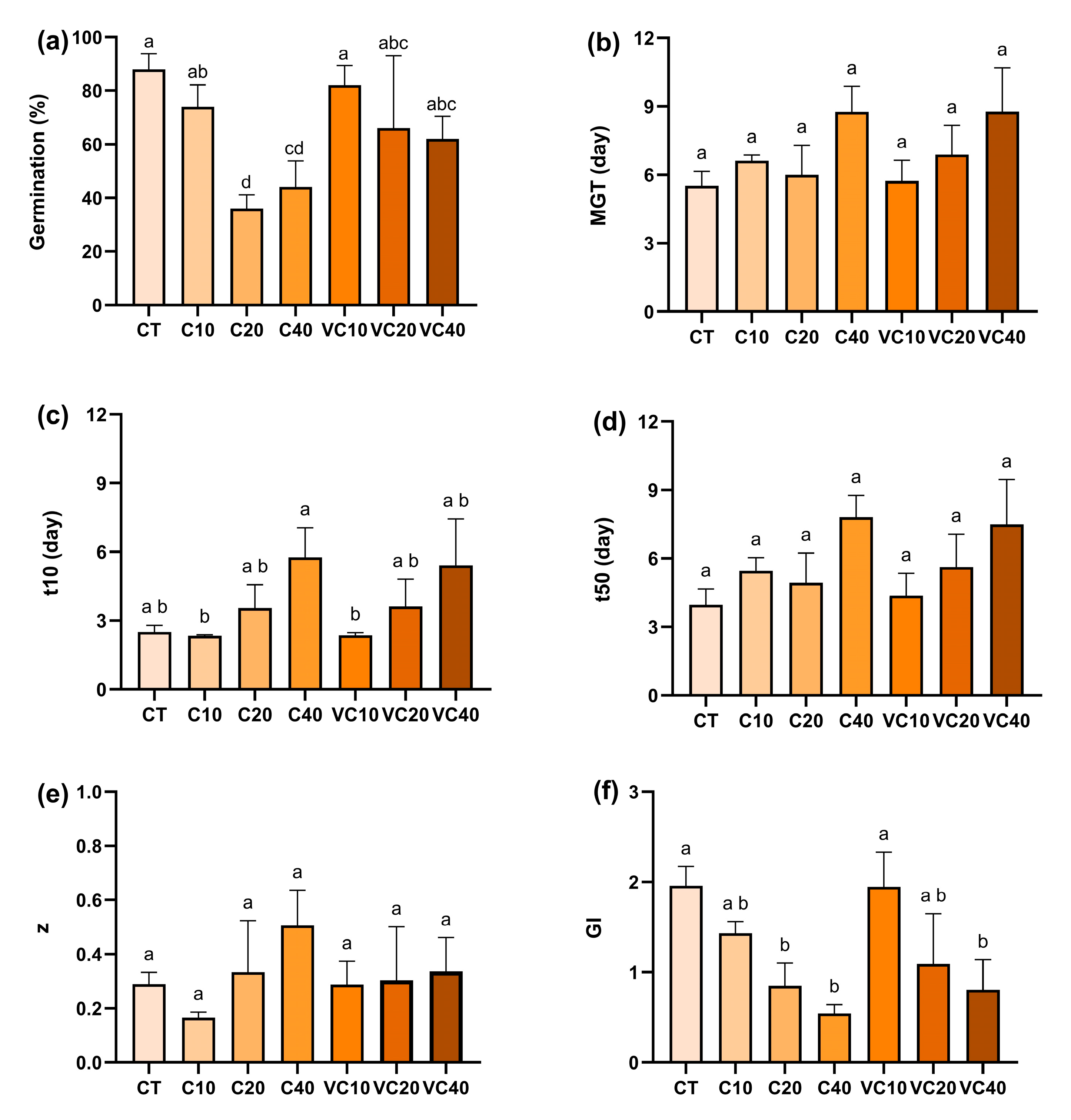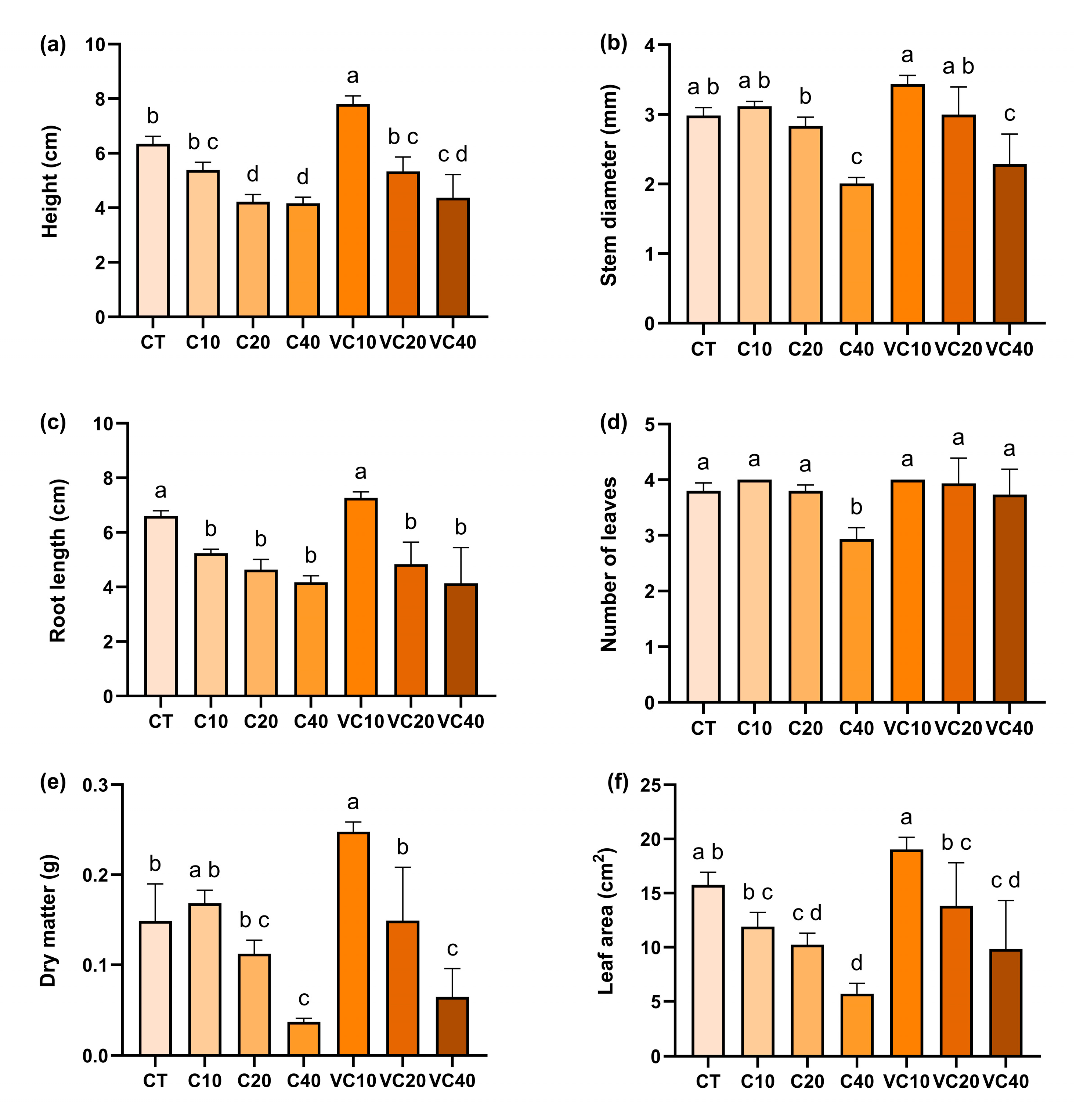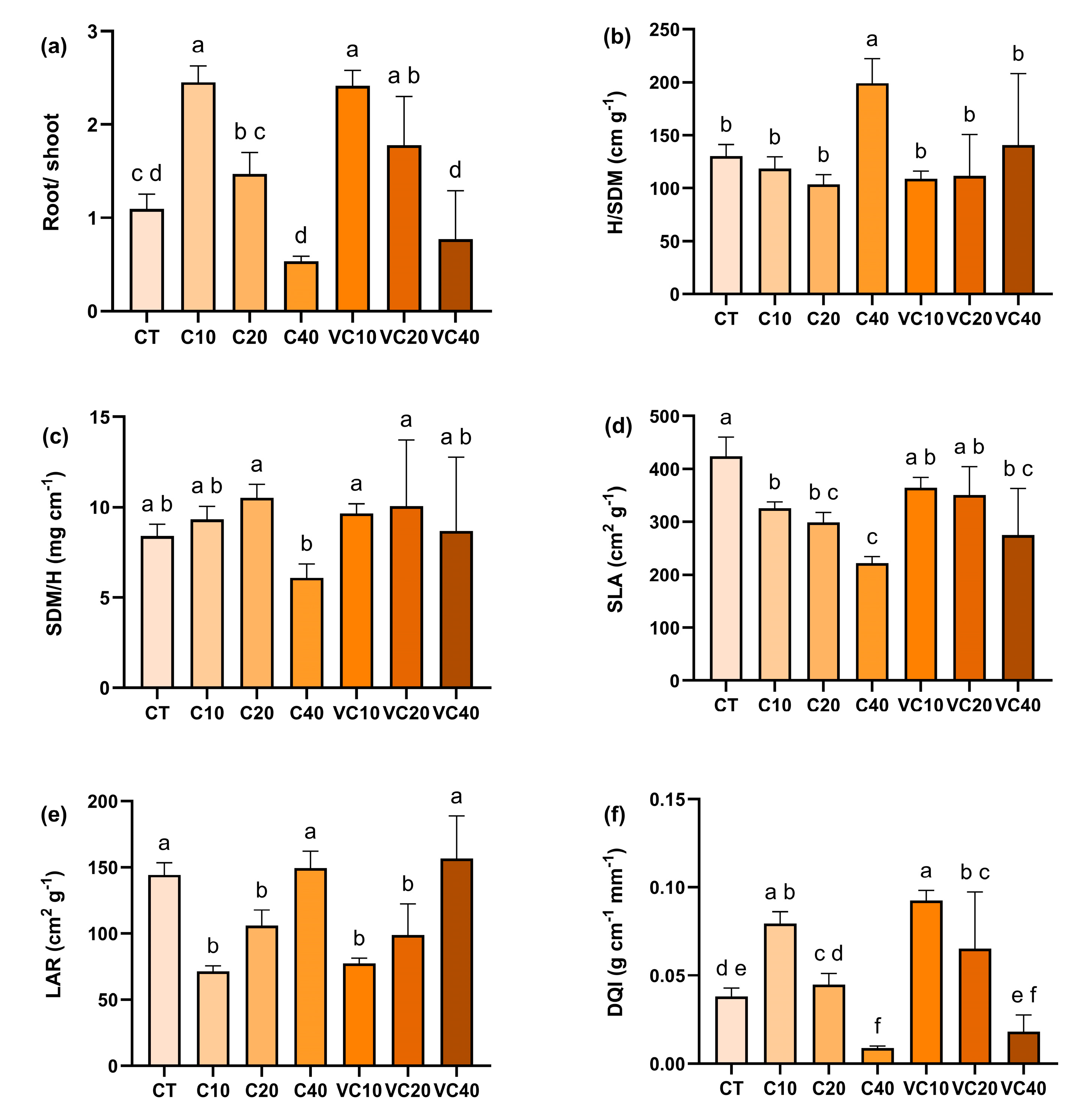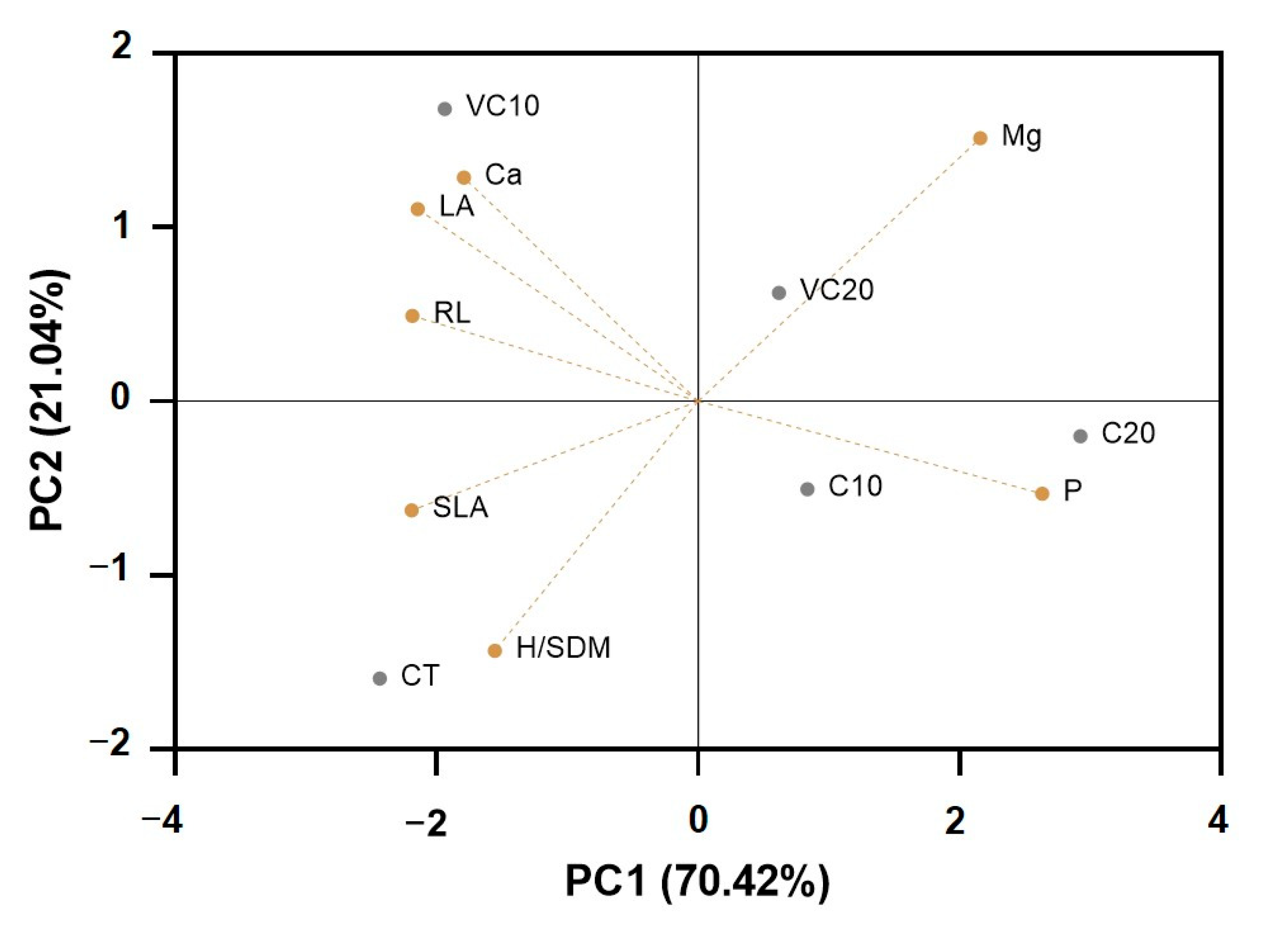Compost and Vermicompost from Vine Pruning and Sewage Sludge as Peat Alternatives in Cucumber Seedling Production
Abstract
1. Introduction
2. Material and Methods
2.1. Compost and Vermicompost Production
2.2. Substrate Preparation and Treatments
2.3. Experimental Setup
2.4. Data Collection
2.5. Statistical Analysis
3. Results
3.1. Germination Performance
3.2. Morphological Traits and Seedling Quality
3.3. Shoot Nutrient Content and Integrative Analyses
4. Discussion
5. Conclusions
Author Contributions
Funding
Data Availability Statement
Conflicts of Interest
References
- Puglia, D.; Pezzolla, D.; Gigliotti, G.; Torre, L.; Bartucca, M.L.; Del Buono, D. The Opportunity of Valorizing Agricultural Waste, Through Its Conversion into Biostimulants, Biofertilizers, and Biopolymers. Sustainability 2021, 13, 2710. [Google Scholar] [CrossRef]
- de Sousa Antunes, L.F.; de Sousa Vaz, A.F.; Martelleto, L.A.P.; de Almeida Leal, M.A.; dos Santos Alves, R.; dos Santos Ferreira, T.; Guerra, J.G.M. Sustainable Organic Substrate Production Using Millicompost in Combination with Different Plant Residues for the Cultivation of Passiflora edulis Seedlings. Environ. Technol. Innov. 2022, 28, 102612. [Google Scholar] [CrossRef]
- Bhatia, T.; Sindhu, S.S. Sustainable Management of Organic Agricultural Wastes: Contributions in Nutrients Availability, Pollution Mitigation and Crop Production. Discov. Agric. 2024, 2, 130. [Google Scholar] [CrossRef]
- Jesus, M.; Romaní, A.; Mata, F.; Domingues, L. Current Options in the Valorisation of Vine Pruning Residue for the Production of Biofuels, Biopolymers, Antioxidants, and Bio-Composites following the Concept of Biorefinery: A Review. Polymers 2022, 14, 1640. [Google Scholar] [CrossRef] [PubMed]
- Rastogi, M.; Nandal, M.; Khosla, B. Microbes as Vital Additives for Solid Waste Composting. Heliyon 2020, 6, e03343. [Google Scholar] [CrossRef]
- Suvendran, S.; Acevedo, M.F.; Smithers, B.; Walker, S.J.; Xu, P. Soil Fertility and Plant Growth Enhancement Through Compost Treatments Under Varied Irrigation Conditions. Agriculture 2025, 15, 734. [Google Scholar] [CrossRef]
- Oueld Lhaj, M.; Moussadek, R.; Mouhir, L.; Sanad, H.; Manhou, K.; Iben Halima, O.; Yachou, H.; Zouahri, A.; Mdarhri Alaoui, M. Application of Compost as an Organic Amendment for Enhancing Soil Quality and Sweet Basil (Ocimum basilicum L.) Growth: Agronomic and Ecotoxicological Evaluation. Agronomy 2025, 15, 1045. [Google Scholar] [CrossRef]
- Lim, S.L.; Lee, L.H.; Wu, T.Y. Sustainability of Using Composting and Vermicomposting Technologies for Organic Solid Waste Biotransformation: Recent Overview, Greenhouse Gases Emissions and Economic Analysis. J. Clean. Prod. 2016, 111, 262–278. [Google Scholar] [CrossRef]
- Vyas, P.; Sharma, S.; Gupta, J. Vermicomposting with Microbial Amendment: Implications for Bioremediation of Industrial and Agricultural Waste. BioTechnologia 2022, 103, 203–215. [Google Scholar] [CrossRef]
- Vidal, A.; Blouin, M.; Lubbers, I.M.; Capowiez, Y.; Sanchez-Hernandez, J.; Calogiuri, T.; Van Groenigen, J.W. The Role of Earthworms in Agronomy: Consensus, Novel Insights and Remaining Challenges. Adv. Agron. 2023, 181, 1–78. [Google Scholar]
- Oyege, I.; Balaji Bhaskar, M.S. Effects of Vermicompost on Soil and Plant Health and Promoting Sustainable Agriculture. Soil Syst. 2023, 7, 101. [Google Scholar] [CrossRef]
- Al-Tawarah, B.; Alasasfa, M.A.; Mahadeen, A.Y. Efficacy of Compost and Vermicompost on Growth, Yield and Nutrients Content of Common Beans Crop (Phaseolus vulgaris L.). J. Ecol. Eng. 2024, 25, 215–226. [Google Scholar] [CrossRef]
- Edlinger, A.; Herzog, C.; Garland, G.; Walder, F.; Banerjee, S.; Keel, S.G.; Mayer, J.; Philippot, L.; Romdhane, S.; Schiedung, M.; et al. Compost Application Enhances Soil Health and Maintains Crop Yield: Insights from 56 Farmer-Managed Arable Fields. J. Sustain. Agric. Environ. 2025, 4, e70041. [Google Scholar] [CrossRef]
- Hrčka, M.; Kraus, K.; Hřebečková, T.; Tunklová, B.; Kubeš, J.; Hanč, A. Effects of Sewage Sludge Compost and Vermicompost on Wheat Yield and Vitality. Agriculture 2025, 15, 551. [Google Scholar] [CrossRef]
- Gruda, N. Increasing Sustainability of Growing Media Constituents and Stand-Alone Substrates in Soilless Culture Systems. Agronomy 2019, 9, 298. [Google Scholar] [CrossRef]
- Hirschler, O.; Thrän, D. Peat Substitution in Horticulture: Interviews with German Growing Media Producers on the Transformation of the Resource Base. Horticulturae 2023, 9, 919. [Google Scholar] [CrossRef]
- Mechergui, T.; Vanderschaaf, C.L.; Pardos, M. From Waste to Plant Production: Cattle Dung Compost as an Alternative Nursery Substrate to Commercial Peat for Producing Lettuce Plants. HortScience 2024, 59, 1489–1496. [Google Scholar] [CrossRef]
- Agarwal, P.; Saha, S.; Hariprasad, P. Agro-Industrial-Residues as Potting Media: Physicochemical and Biological Characters and Their Influence on Plant Growth. Biomass Convers. Biorefinery 2023, 13, 9601–9624. [Google Scholar] [CrossRef]
- Rotowa, O.J.; Małek, S.; Jasik, M.; Staszel-Szlachta, K. Substrate and Fertilization Used in the Nursery Influence Biomass and Nutrient Allocation in Fagus sylvatica and Quercus robur Seedlings After the First Year of Growth in a Newly Established Forest. Forests 2025, 16, 511. [Google Scholar] [CrossRef]
- Pascual, J.A.; Ceglie, F.; Tuzel, Y.; Koller, M.; Koren, A.; Hitchings, R.; Tittarelli, F. Organic Substrate for Transplant Production in Organic Nurseries. A Review. Agron. Sustain. Dev. 2018, 38, 35. [Google Scholar] [CrossRef]
- Gavilanes-Terán, I.; Jara-Samaniego, J.; Idrovo-Novillo, J.; Bustamante, M.A.; Pérez-Murcia, M.D.; Pérez-Espinosa, A.; López, M.; Paredes, C. Agroindustrial Compost as a Peat Alternative in the Horticultural Industry of Ecuador. J. Environ. Manag. 2017, 186, 79–87. [Google Scholar] [CrossRef]
- Räsänen, A.; Albrecht, E.; Annala, M.; Aro, L.; Laine, A.M.; Maanavilja, L.; Mustajoki, J.; Ronkanen, A.-K.; Silvan, N.; Tarvainen, O.; et al. After-Use of Peat Extraction Sites–A Systematic Review of Biodiversity, Climate, Hydrological and Social Impacts. Sci. Total Environ. 2023, 882, 163583. [Google Scholar] [CrossRef] [PubMed]
- Abdel-Razzak, H.; Alkoaik, F.; Rashwan, M.; Fulleros, R.; Ibrahim, M. Tomato Waste Compost as an Alternative Substrate to Peat Moss for the Production of Vegetable Seedlings. J. Plant Nutr. 2019, 42, 287–295. [Google Scholar] [CrossRef]
- Gong, X.; Li, S.; Sun, X.; Wang, L.; Cai, L.; Zhang, J.; Wei, L. Green Waste Compost and Vermicompost as Peat Substitutes in Growing Media for Geranium (Pelargonium zonale L.) and Calendula (Calendula officinalis L.). Sci. Hortic. 2018, 236, 186–191. [Google Scholar] [CrossRef]
- Gruda, N.S.; Hirschler, O.; Stuart, J. Peat Reduction in Horticulture–an Overview of Europe. Acta Hortic. 2024, 1391, 545–560. [Google Scholar] [CrossRef]
- Calisti, R.; Regni, L.; Pezzolla, D.; Cucina, M.; Gigliotti, G.; Proietti, P. Evaluating Compost from Digestate as a Peat Substitute in Nursery for Olive and Hazelnut Trees. Sustainability 2022, 15, 282. [Google Scholar] [CrossRef]
- Adamczewska-Sowińska, K.; Sowiński, J.; Jamroz, E.; Bekier, J. The Effect of Peat Replacement in Horticulture Media by Willow (Salix viminalis L.) Biomass Compost for Cucumber Transplant Production. Front. Plant Sci. 2024, 15, 1348073. [Google Scholar] [CrossRef]
- Büyükarslan, D.; Demir, H. Effects of Vermicompost as an Alternative Substrate on Yield and Quality of Cauliflower and Pepper Seedlings. Not. Bot. Horti Agrobot. 2024, 52, 13587. [Google Scholar] [CrossRef]
- Lazcano, C.; Arnold, J.; Tato, A.; Zaller, J.G.; Domínguez, J. Compost and Vermicompost as Nursery Pot Components: Effects on Tomato Plant Growth and Morphology. Span. J. Agric. Res. 2009, 7, 944–951. [Google Scholar] [CrossRef]
- Coutinho, J.; Sá, C.; Trindade, A. Manual de Colheita de Amostras e de Dados No Campo; Sistema de Monitorização Nacional Do Solo; DGADR: Lisbon, Portugal, 2024.
- Huang, K.; Li, F.; Li, J.; Helard, D.; Hirooka, K. Rapid Vermicomposting of Fresh Fruit and Vegetable Wastes Using Earthworm Eisenia foetida. J. Jpn. Soc. Civ. Eng. Ser. G Environ. Res. 2012, 68, 113–120. [Google Scholar] [CrossRef]
- Ballesta, J.; García-Navarro, F.J.; García-Giménez, R.; Trujillo-Gonzalez, J.M.; Iñigo, V.; Asensio, C. Agroecological Analysis of Cucumber (Cucumis sativus L.) Crops in Orchards in a Mediterranean Environment. J. Agric. Crops 2018, 4, 16–28. [Google Scholar]
- Chen, T.-W.; Gomez Pineda, I.M.; Brand, A.M.; Stützel, H. Determining Ion Toxicity in Cucumber under Salinity Stress. Agronomy 2020, 10, 677. [Google Scholar] [CrossRef]
- Brandenberger, L.; Shrefler, J.; Rebek, E.; Damicone, J. Cucumber Production; HLA-6023; Oklahoma Cooperative Extension Service: Stillwater, OK, USA, 2021. [Google Scholar]
- Ranal, M.A.; Santana, D.G.D. How and Why to Measure the Germination Process? Rev. Bras. Botânica 2006, 29, 1–11. [Google Scholar] [CrossRef]
- Dickson, A.; Leaf, A.L.; Hosner, J.F. Quality Appraisal of White Spruce and White Pine Seedling Stock in Nurseries. For. Chron. 1960, 36, 10–13. [Google Scholar] [CrossRef]
- Atiyeh, R.M.; Edwards, C.A.; Subler, S.; Metzger, J.D. Pig Manure Vermicompost as a Component of a Horticultural Bedding Plant Medium: Effects on Physicochemical Properties and Plant Growth. Bioresour. Technol. 2021, 78, 11–20. [Google Scholar] [CrossRef] [PubMed]
- Peña, H.; Diánez, F.; Ramírez, B.; Sulbarán, J.; Arias, K.; Huertas, V.; Santos, M. Compost and Vermicompost as Substrates Enriched with Trichoderma asperellum for the Production of Basic Potato Seed in the Venezuelan Andes. Horticulturae 2025, 11, 124. [Google Scholar] [CrossRef]
- Arancon, N.Q.; Edwards, C.A.; Atiyeh, R.; Metzger, J.D. Effects of Vermicomposts Produced from Food Waste on the Growth and Yields of Greenhouse Peppers. Bioresour. Technol. 2004, 93, 139–144. [Google Scholar] [CrossRef]
- Ali, M.; Griffiths, A.J.; Williams, K.P.; Jones, D.L. Evaluating the Growth Characteristics of Lettuce in Vermicompost and Green Waste Compost. Eur. J. Soil Biol. 2007, 43, S316–S319. [Google Scholar] [CrossRef]
- Rivera, B.; Quej, V.H.; Gutiérrez, R.; Andrade, J.L.; Carrillo, E.; González, V.; Villarreal, E.C. Use of Organic Substrates on the Quality of Watermelon Seedlings. Hortic. Bras. 2022, 40, 261–267. [Google Scholar] [CrossRef]
- Bustamante, M.A.; Paredes, C.; Moral, R.; Moreno-Caselles, J.; Pérez-Espinosa, A.; Pérez-Murcia, M.D. Compost from Winery Wastes as Peat Substitutes: Physicochemical and Chemical Properties. Bioresour. Technol. 2008, 99, 701–707. [Google Scholar] [CrossRef]
- Jankauskienė, J.; Laužikė, K.; Kavaliauskaitė, D. Effects of Vermicompost on Quality and Physiological Parameters of Cucumber (Cucumis sativus L.) Seedlings and Plant Productivity. Horticulturae 2022, 8, 1009. [Google Scholar] [CrossRef]
- Tsakaldimi, M.; Ganatsas, P.; Jacobs, D.F. Prediction of Planted Seedling Survival of Five Mediterranean Species Based on Initial Seedling Morphology. New For. 2013, 44, 327–339. [Google Scholar] [CrossRef]
- Rocha, J.F.; Kusdra, J.F.; Moreno, A.D.L.; Picazevicz, A.A.C. Growth and Production of Lettuce on Substrates Based on Detritivorous Earthworms Drilocomposts. Comun. Sci. 2022, 13, e3646. [Google Scholar] [CrossRef]
- Ban, S.; Hong, I.; Kwack, Y. Prediction of Growth and Quality of Chinese Cabbage Seedlings Cultivated in Different Plug Cell Sizes via Analysis of Image Data Using Multispectral Camera. Horticulturae 2023, 9, 1288. [Google Scholar] [CrossRef]
- Gallegos-Cedillo, V.M.; Diánez, F.; Nájera, C.; Santos, M. Plant Agronomic Features Can Predict Quality and Field Performance: A Bibliometric Analysis. Agronomy 2021, 11, 2305. [Google Scholar] [CrossRef]
- Čepulienė, R.; Butkevičienė, L.M.; Steponavičienė, V. Nutrient Use Efficiency and Cucumber Productivity as a Function of the Nitrogen Fertilization Rate and the Wood Fiber Content in Growing Media. Plants 2024, 13, 2911. [Google Scholar] [CrossRef] [PubMed]
- Gopinath, K.A.; Saha, S.; Mina, B.L.; Pande, H.; Kundu, S.; Gupta, H.S. Influence of Organic Amendments on Growth, Yield and Quality of Wheat and on Soil Properties During Transition to Organic Production. Sci. Hortic. 2008, 118, 120–126. [Google Scholar] [CrossRef]
- García-Gómez, A.; Bernal, M.P.; Roig, A. Growth of Ornamental Plants in Two Composts Prepared from Agroindustrial Wastes. Bioresour. Technol. 2002, 83, 81–87. [Google Scholar] [CrossRef]
- Laužikė, K.; Laužikas, V.; Jankauskienė, J. The Impact of Vermicompost on the Quality of Lettuce (Lactuca sativa) Seedlings and Plant Productivity. Biol. Life Sci. Forum 2025, 41, 7. [Google Scholar] [CrossRef]
- Daničić, M.; Vraneš, M.; Putnik-Delić, M.; Tot, A.; Weihs, P.; Maksimović, I. Mineral Composition and Growth of Tomato and Cucumber Affected by Imidazolium-Based Ionic Liquids. Plant Physiol. Biochem. 2021, 167, 132–139. [Google Scholar] [CrossRef] [PubMed]
- Cheng, H.; Che, M.; Hu, W.; Wu, Q.; Cheng, Y.; Hu, X.; Xiong, S.; Zheng, J.; Gong, Y. Soil-Available Nutrients Associated with Soil Chemical and Aggregate Properties following Vegetation Restoration in Western Sichuan, China. Forests 2023, 14, 259. [Google Scholar] [CrossRef]
- Uddin, S.; Zaman, M.; Martínez-Guijarro, K.; Al-Murad, M.; Behbehani, M.; Habibi, N.; Al-Mutairi, A. Sewage Sludge as Soil Amendment in Arid Soils–A Trace Metal, Nutrient and Trace Organics Perspective. Emerg. Contam. 2025, 11, 100420. [Google Scholar] [CrossRef]





| Parameter | Compost | Vermicompost | Commercial Substrate |
|---|---|---|---|
| Moisture (g kg−1) | 511 | 535 | 415 |
| pH (H2O) # | 6.0 | 5.6 | 5.8 |
| Organic matter (mg kg−1 DW) | 860 | 849 | 749 |
| Electrical conductivity (dS m−1) # | 1.7 | 2.7 | 0.8 |
| N (g kg−1 DW) | 35.1 | 33.0 | 7.7 |
| P (g kg−1 DW) | 7.3 | 6.2 | 1.4 |
| K (g kg−1 DW) | 16.8 | 16.9 | 4.3 |
| Ca (g kg−1 DW) | 17.5 | 18.5 | 17.3 |
| Mg (g kg−1 DW) | 5.0 | 4.6 | 1.7 |
| S (g kg−1 DW) | 3.7 | 3.6 | 1.7 |
| B (mg kg−1 DW) | 25.0 | 30.0 | 10.7 |
| Fe (mg kg−1 DW) | 3429 | 3841 | 5051 |
| Cu (mg kg−1 DW) | 116 | 106 | 14 |
| Zn (mg kg−1 DW) | 352 | 335 | 43 |
| Mn (mg kg−1 DW) | 231 | 239 | 164 |
| Ni (mg kg−1 DW) | 6.7 | 6.1 | 5.5 |
| Cd (mg kg−1 DW) | 0.3 | 0.4 | 0.1 |
| Pb (mg kg−1 DW) | 15.3 | 15.8 | 7.4 |
| Cr (mg kg−1 DW) | 6.7 | 8.3 | 11.4 |
| Hg (μg kg−1 DW) | 15.2 | 97.6 | 15.4 |
| C/N | 14 | 15 | 56 |
| NH4+-N/NO3−-N | 0.271 | 0.013 | 0.055 |
| Substrates | Organic Matter (g kg−1 DW) | pH (H2O) # | Electrical Conductivity # (dS m−1) | Total C (g kg−1 DW) |
|---|---|---|---|---|
| CT | 536 | 5.78 | 0.524 | 311 |
| C10 | 525 | 5.54 | 0.959 | 304 |
| C20 | 556 | 5.57 | 1.550 | 323 |
| C40 | 554 | 5.69 | 1.715 | 321 |
| VC10 | 553 | 6.10 | 0.304 | 321 |
| VC20 | 562 | 5.68 | 0.794 | 326 |
| VC40 | 580 | 5.62 | 1.181 | 364 |
| Substrates | N | P | K | Ca | Mg | S |
|---|---|---|---|---|---|---|
| CT | 44.28 ± 0.71 c | 9.54 ± 0.14 b | 80.38 ± 0.78 b | 22.27 ± 0.02 b | 6.45 ± 0.05 c | 10.13 ± 0.15 a |
| C10 | 49.85 ± 0.46 b | 10.52 ± 0.13 a | 79.07 ± 0.67 b | 22.89 ± 0.39 b | 7.76 ± 0.07 b | 8.15 ± 0.10 c |
| C20 | 56.37 (n = 1) | 10.73 (n = 1) | 90.40 (n = 1) | 18.43 (n = 1) | 8.41 (n = 1) | 7.50 (n = 1) |
| VC10 | 45.92 ± 0.50 c | 9.52 ± 0.04 b | 91.17 ± 2.07 a | 25.69 ± 0.04 a | 7.76 ± 0.02 b | 8.70 ± 0.10 b |
| VC20 | 56.11 ± 0.29 a | 9.90 ± 0.04 b | 89.10 ± 0.72 a | 22.76 ± 0.19 b | 8.66 ± 0.05 a | 7. 64 ± 0.12 d |
| Substrates | B | Fe | Zn | Mn | Cu |
|---|---|---|---|---|---|
| CT | 47.94 ± 0.22 a | 570.36 ± 0.82 b | 194.00 ± 0.84 a | 69.22 ± 1.08 c | 19.52 ± 0.35 b |
| C10 | 46.59 ± 0.77 ab | 519.63 ± 8.71 c | 146.71 ± 0.78 d | 72.82 ± 0.31 bc | 22.19 ± 0.73 b |
| C20 | 43.52 (n = 1) | 693.55 (n = 1) | 144.15 (n = 1) | 70.92 (n = 1) | 27.41 (n = 1) |
| VC10 | 45.95 ± 0.23 ab | 53.56 ± 0.26 c | 172.84 ± 2.47 c | 74.57 ± 1.36 ab | 22.01 ± 0.62 b |
| VC20 | 45.07 ± 0.66 b | 600.42 ± 2.40 a | 187.24 ± 0.87 b | 77.67 ± 1.02 a | 26.82 ± 1.20 a |
Disclaimer/Publisher’s Note: The statements, opinions and data contained in all publications are solely those of the individual author(s) and contributor(s) and not of MDPI and/or the editor(s). MDPI and/or the editor(s) disclaim responsibility for any injury to people or property resulting from any ideas, methods, instructions or products referred to in the content. |
© 2025 by the authors. Licensee MDPI, Basel, Switzerland. This article is an open access article distributed under the terms and conditions of the Creative Commons Attribution (CC BY) license (https://creativecommons.org/licenses/by/4.0/).
Share and Cite
Morais, M.C.; Azevedo, T.; Lopes, H.; Coimbra, A.M.; Sousa, J.R.; Roboredo, M.; Oliveira, P.A.; Nascimento-Gonçalves, E. Compost and Vermicompost from Vine Pruning and Sewage Sludge as Peat Alternatives in Cucumber Seedling Production. Agronomy 2025, 15, 2519. https://doi.org/10.3390/agronomy15112519
Morais MC, Azevedo T, Lopes H, Coimbra AM, Sousa JR, Roboredo M, Oliveira PA, Nascimento-Gonçalves E. Compost and Vermicompost from Vine Pruning and Sewage Sludge as Peat Alternatives in Cucumber Seedling Production. Agronomy. 2025; 15(11):2519. https://doi.org/10.3390/agronomy15112519
Chicago/Turabian StyleMorais, Maria Cristina, Tiago Azevedo, Henda Lopes, Ana Maria Coimbra, João Ricardo Sousa, Marta Roboredo, Paula Alexandra Oliveira, and Elisabete Nascimento-Gonçalves. 2025. "Compost and Vermicompost from Vine Pruning and Sewage Sludge as Peat Alternatives in Cucumber Seedling Production" Agronomy 15, no. 11: 2519. https://doi.org/10.3390/agronomy15112519
APA StyleMorais, M. C., Azevedo, T., Lopes, H., Coimbra, A. M., Sousa, J. R., Roboredo, M., Oliveira, P. A., & Nascimento-Gonçalves, E. (2025). Compost and Vermicompost from Vine Pruning and Sewage Sludge as Peat Alternatives in Cucumber Seedling Production. Agronomy, 15(11), 2519. https://doi.org/10.3390/agronomy15112519











